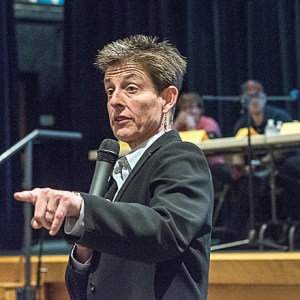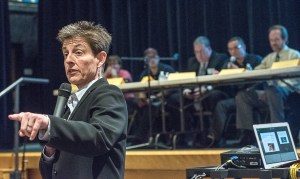LEWISTON — Officially, the discussion on heroin and opioid abuse began at 6 p.m. in the middle school auditorium.
But in an important way, the real meeting started earlier, in the lobby, where men and women talked in hushed tones about the way drug addiction had ravaged their lives.
“It’s been so scary,” one woman said to another. “I just don’t know what to do with him.”
Roughly 60 people turned out Thursday night for “Opiate and Heroin Addiction: What Can Our Community Do About it?” And while the panel was dominated by experts on the matter, there was no shortage of people there with intimate knowledge of addiction.
“The impact it has on a family is devastating,” said a woman named Roxanne, who for 15 years has been contending with her son’s addictions. “It’s the most painful journey I’ve ever been on. It’s the most painful thing in the world to look at your child, but your child no longer exists. His soul is gone.”
Throughout the auditorium, there was a rumble of agreement from the brothers, sisters, parents and friends of those hooked on heroin or related drugs. Nobody had to be convinced that Lewiston-Auburn, and the state as a whole, has an addiction problem. The numbers tell the tale.
Across Maine, 272 people died of opiate overdose in 2015, an increase of 31 percent over the year before.
At St. Mary’s Regional Medical Center alone, 1,288 patients were treated for drug addiction, with the ICU department handling 27 overdoses.
Then there are the 3.9 percent of high school kids in Androscoggin County who admit to using heroin at least once. And the 5.1 percent of high school students who admit to using prescription drugs such as Vicodin and OxyContin.
Nobody denies that it’s an epidemic. On the panel, the experts told their tales.
Dr. Michael Kelley, a psychiatrist who works with substance abusers at St. Mary’s, recalled coming on board 18 years ago to find 17 alcoholics and one drug addict who had come in for help.
“In 18 years, that’s flipped completely,” Kelley said. Today, the hospital is treating 17 people who are there for opiate addiction. Only one came in for help with alcoholism.
“It’s an amazing epidemic and it’s terrifying,” Kelley said. “The numbers are just getting horrible.”
And as the problem gets worse, so does the ability to treat the afflicted, Kelley said. He recalled a time when the average wait for a bed in a rehabilitation center was just a few days. Today, the average period is two months before an addict can be admitted.
A lot of the detox centers, rehabs and halfway houses have closed their doors. Changes in the insurance system make financing for treatment elusive.
“The resources had dwindled dramatically,” Kelley said. “It’s incredibly frustrating.”
Matt Cashman, a 20-year veteran of the Lewiston police force and now supervisor of the Maine Drug Enforcement Agency, has seen the changes, too. Gone are the old stereotypes where only young, inner-city folks were getting hooked. These days, addiction to opiates transcends gender, age and income. People from all walks are getting addicted.
“It’s everywhere in Lewiston,” Cashman said. “It’s not just downtown.”
One recent week, Cashman went to Auburn to investigate a pair of fatal overdoses. That was followed by another in Lewiston. As bad as it is, he said, the numbers could be much higher if medical response times weren’t as quick as they are in this relatively small community.
Cashman and his agency have been contending with drug abusers who don’t always know the purity of the drug they’re putting into their bodies. They’ve seen a significant problem with people taking fentanyl, a synthetic opiate often 50-60 times more potent than other abused drugs.
But it’s not only the abuser who suffers.
Travis Doboszenski, of Tri-County Mental Health Services, talked about “the destruction of relationships” as the addicted descend further and further into chaos and isolation. For their loved ones, life becomes a vigil of waiting for the worst.
“The emotional pain is almost unbearable,” said Roxanne. “You carry it with you every day and every night as you wait for that call.”
Vicky Wiegman, a substance-abuse counselor at Lewiston High School, provided the audience with more staggering numbers, including the 2.7 percent of kids still in middle school who admit trying prescription drugs recreationally.
Bruce King, of Grace Street Recovery Services, told his personal story of addiction and the road to recovery that included long stretches in prison and suicidal depression.
Mostly they talked about the frustrations of trying to help addicts when money and resources are in short supply. They threw around suggestions and promised to talk more later.
When the audience got a chance to speak, they spoke plenty. One woman described the plight of trying to get help for her addicted and now-jailed daughter: battles with the court system and the medical system where it seemed almost impossible to succeed.
“The system,” the woman said, “is beyond broken.”
Meanwhile, police officials say, the problem shows no sign of getting better and the numbers associated with opiate addiction keep getting worse.
“It’s tragic,” Cashman said. “And it’s frustrating.”
According to the Maine Attorney General’s Office, 107 people died from heroin overdoses and 157 died from heroin, fentanyl, acetyl fentanyl or some combination in 2015. In addition, about 15,500 Mainers received opioid addiction treatment in 2015.
In response to these staggering statistics, community partners in Androscoggin County hosted the Opiate and Heroin Listening Session. Carol Kelly of Pivot Point facilitated the event that featured panelists from schools, prevention, law enforcement, physicians, treatment, recovery and family members.


Comments are no longer available on this story